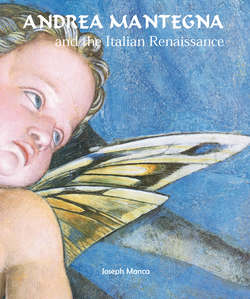Andrea Mantegna and the Italian Renaissance

Реклама. ООО «ЛитРес», ИНН: 7719571260.
Оглавление
Joseph Manca. Andrea Mantegna and the Italian Renaissance
Mantegna as Artistic Revolutionary
The Debut of a Prodigy: Mantegna’s Early years in Padua
Mantegna as Court Painter in Mantua
Piety and Passion in Mantegna’s Later Religious Works
The “Triumphs of Caesar” and Other Visions of Antiquity
Mantegna and the Art of Printmaking
Patroness and Painter: The “Studiolo” of Isabella d’Este
Mantegna’s Place in History
Bibliography
Отрывок из книги
1. The Holy Family with St Elizabeth and the young St John, c. 1485–1488. Tempera and gold on canvas, 62.9 × 51.3 cm. Kimbell Art Museum, Fort Worth.
The art of Andrea Mantegna (born c.1431, died 1506) has long maintained a broad and deep appeal. From the impressive illusionism of his earliest works (Fig. 4) to the narrative power of his mature paintings (Fig. 2), Mantegna’s art remained vivid and heroic, dramatic and emotional. They are also painted in stunning detail: pebbles, blades of grass, veins, and hair are rendered with excruciating care, and he depicted even in his great narrative works the mundane particulars of earthly existence, showing laundry hanging out to dry and buildings fallen into disrepair. He had a deep interest in human nature and issues of moral character. Perhaps most strikingly, Mantegna’s pictures are filled with references to classical antiquity. No other painter of the fifteenth century so thoroughly understood and abundantly included in his art the costumes, drapery folds, inscriptions, architecture, subject matter, ethical attitude, and other aspects of ancient classical civilisation. And instead of the cool classicism of later centuries, his vision of Greco-Roman civilisation is lively and has a familiar and nostalgic air about it. For him, antiquity was a near, palpable presence, one which he sought constantly to bring to colourful existence in his pictures. It is this thirst for a vanished classical past that places Mantegna most firmly in the context of his time, as his art was favoured most warmly by Renaissance contemporaries who shared his visionary quest to revive the moral strength and naturalism which marked the art of antiquity.
.....
17. Masaccio, The Tribute Money, c. 1428. Fresco, 255 × 598 cm. Brancacci Chapel, Santa Maria del Camine, Florence.
Perspective, an important aspect of Renaissance visual culture, was a way to organise the chaos of visual experience, using an orderly, mathematical system. Artistic perspective is an objective and scientific method of spatial organisation, but it is also intensely subjective, showing the world as if seen by an individual spectator who occupies a particular position in the world. Medieval artists, with their otherworldly vision, were not interested in such a rigorous organisation of picture space. The system did contain two appealing aspects for Italians of the fifteenth century, for it is timelessly mathematical on the one hand and very personal on the other. It became the standard system of spatial organisation in Italian painting, although, as with other innovations, its adoption happened over the course of two generations, occurring one city and one artist at a time.
.....